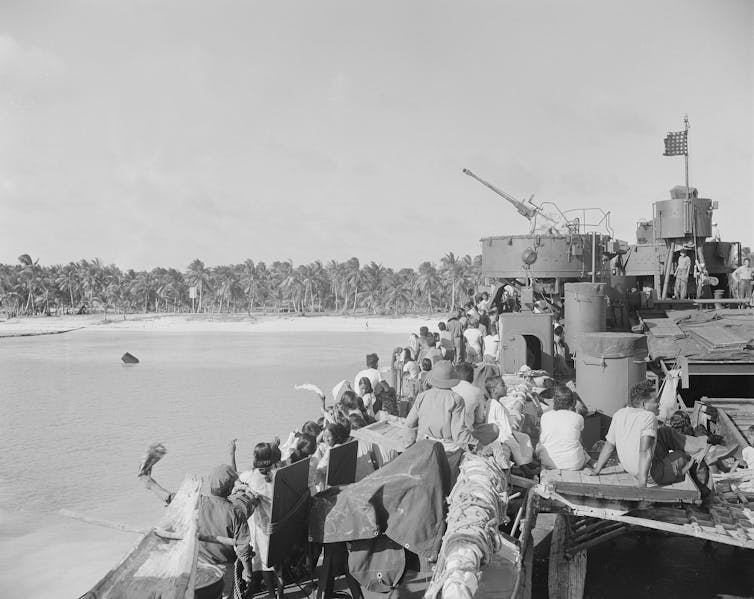SpongeBob's Bikini Bottom is based on a real-life test site for nuclear weapons
- Written by Holly M. Barker, Senior Lecturer, University of Washington
“Who lives in a pineapple under the sea?”
My anthropology class replied, “SpongeBob SquarePants.” Their thunderous response filled the auditorium.
Nearly 20 years ago, the underwater world of SpongeBob and his quirky, colorful friends debuted as a cartoon. The cultural icon is now a Broadway musical, up for 12 Tony awards[1].
My follow-up question, however, was met with silence: I asked students what they could tell me about the real Bikini Bottom.
Bikini Bottom, SpongeBob’s fictional home, is based on an actual place in the Pacific Ocean.
But how much do most Americans know of the real-life Bikini Atoll[2], the location of 23 U.S. nuclear weapons tests during the Cold War era?
Bikini is the anglicized, or colonial, spelling of Pikinni Atoll, a group of islands within the Marshall Islands that includes a lagoon. The Marshall Islands, a former colony of the United States, is a group of islands that spread across 1 million square miles of ocean just north of the equator, about halfway between Hawaii and Papua New Guinea.
In the aftermath of World War II, the United Nations made the United States the governing body for a vast swath of the northern Pacific, including the Marshall Islands. The U.S. subsequently used Bikini as one of two locations, along with Enewetak to the west of Bikini, to test and develop[3] advancements in nuclear weapons technology during the Cold War. Between 1946 and 1958, the U.S. government detonated 67 nuclear weapons on these islands.
In 1946, the U.S. government removed 167 Bikinians[4] and relocated them to the islands of Rongerik, east of Bikini, where they experienced starvation because of inadequate food crop. On March 1, 1954, a detonation on Bikini Atoll known as “Bravo” created an explosion equivalent to 1,000 Hiroshima-sized bombs.
 In this March 14, 1946, file photo, native people wave farewell to their Bikini Atoll home.
AP Photo/Clarence Hamm, File
In this March 14, 1946, file photo, native people wave farewell to their Bikini Atoll home.
AP Photo/Clarence Hamm, File
This monstrous detonation created real-life horror for Bikinians and their future generations. The displaced Bikini people are now exiles[5]. They cannot return to their ancestral homelands due to radiation contamination that will not dissipate for thousands of years.
In the 1970s, the U.S. government returned nearly 200 Bikinians[6] to their home islands. However, the U.S. government removed the people again in 1978, because they were found to have ingested more radioactive cesium from the environment than any known human population.
Elements of this history make brief appearances in episodes of the SpongeBob cartoon that few viewers likely pick up on.
References
- ^ 12 Tony awards (www.playbill.com)
- ^ Bikini Atoll (www.bikiniatoll.com)
- ^ test and develop (theconversation.com)
- ^ removed 167 Bikinians (onlinelibrary.wiley.com)
- ^ are now exiles (www.dailymail.co.uk)
- ^ returned nearly 200 Bikinians (books.google.com)
Authors: Holly M. Barker, Senior Lecturer, University of Washington

